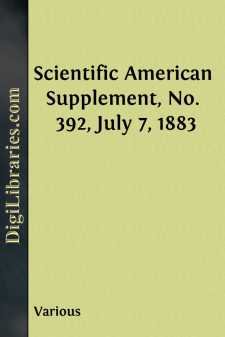Categories
- Antiques & Collectibles 13
- Architecture 36
- Art 48
- Bibles 22
- Biography & Autobiography 813
- Body, Mind & Spirit 142
- Business & Economics 28
- Children's Books 15
- Children's Fiction 12
- Computers 4
- Cooking 94
- Crafts & Hobbies 4
- Drama 346
- Education 46
- Family & Relationships 57
- Fiction 11828
- Games 19
- Gardening 17
- Health & Fitness 34
- History 1377
- House & Home 1
- Humor 147
- Juvenile Fiction 1873
- Juvenile Nonfiction 202
- Language Arts & Disciplines 88
- Law 16
- Literary Collections 686
- Literary Criticism 179
- Mathematics 13
- Medical 41
- Music 40
- Nature 179
- Non-Classifiable 1768
- Performing Arts 7
- Periodicals 1453
- Philosophy 64
- Photography 2
- Poetry 896
- Political Science 203
- Psychology 42
- Reference 154
- Religion 513
- Science 126
- Self-Help 84
- Social Science 81
- Sports & Recreation 34
- Study Aids 3
- Technology & Engineering 59
- Transportation 23
- Travel 463
- True Crime 29
Scientific American Supplement, No. 392, July 7, 1883
by: Various
Categories:
Description:
Excerpt
IMPROVED DYNAMO MACHINE.
The continuous current and the alternating current generators invented by Dr. J. Hopkinson and Dr. Alexander Muirhead are peculiarly interesting as being probably the first in which the bobbins of the armature were wound with copper ribbon and arranged on a disk armature much in the same way as was afterward done by Sir William Thomson and by Mr. Ferranti. In the Muirhead-Hopkinson machine the armature coils are attached to a soft iron ring, whereas in the Ferranti the iron core is dispensed with, and a gain of lightness in the armature or rotating part effected; this advantage is of considerable importance, though Messrs. Hopkinson and Muirhead can of course reduce the weight of this iron core to insignificant proportions.
[Illustration: HOPKINSON & MUIRHEAD'S DYNAMO-ELECTRIC GENERATOR.]
The general form of this generator is clearly shown by the side and end elevation.
The armature is made by taking a pulley and encircling it with a rim of sheet-iron bands, each insulated from the other by asbestos paper. On one or both sides of the rim thus formed, radial slots are cut to admit radial coils of insulated copper wire or ribbon, so that they lie in planes parallel to the plane of the pulley. In the continuous current machine coils are placed on both sides of the iron rim and arranged alternately, that on the one side always covering the gap between two on the other side. In this way, when a coil on one side of the rim is at its "dead point" and yields its minimum of current, the corresponding coil on the other side is giving out its maximum.
The field magnets are made in a similar manner to the armature and run in circles parallel to the rim of the latter. The cores may be built up of wrought iron as the rim of the armature is; but it is found cheaper to make them of solid wrought or cast iron. To stop the local induced currents in the core, however, Messrs. Muirhead and Hopkinson cut grooves in the faces of the iron cores, and fill them up with sheet-iron strips insulated from each other, similar to the sheet-iron rim of the armature.
The coils, both in the armature and electro-magnets, are packed as closely as they may to each other, and have thus a compressed or quadrilateral shape. The arrangement is shown in Figs. 1 and 2, which represent, in side view and plan, the armature pulley with the soft iron rim and coils attached. There a is the pulley which is keyed to the shaft of the machine, and is encircled with bands of sheet iron, b, insulated from each other by ribbons of asbestos paper laid between every two bands. When the rim has been built up in this way, radial holes are drilled through it from the outer edge inward, and the whole rim is bound together by bolts, d, inserted in the holes and secured by cottars, e. Radial slots are then cut on each side of the rim all round, and the coils of wire mounted on them.
Figs. 3 and 4 show the armature of the continuous current dynamo, with the coils on one side of the rim, half way between the coils on the other side, so as to give a more continuous current....












